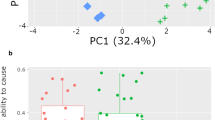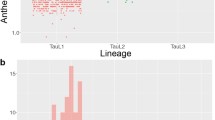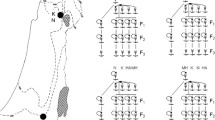Abstract
The tempo, mode, and geography of allopolyploid speciation are influenced by natural variation in the ability of parental species to express postzygotic reproductive phenotypes that affect hybrid fertility. To shed light on the impact of such natural variations, we used allohexaploid Triticum aestivum wheats’ evolution as a model and analyzed the geographic and phylogenetic distributions of Aegilops tauschii (diploid progenitor) accessions involved in the expression of abnormality and fertility in triploid F1 hybrids with Triticum turgidum (tetraploid progenitor). Artificial-cross experiments and chloroplast-DNA-based evolutionary analyses showed that hybrid-abnormality-causing accessions had limited geographic and phylogenetic distributions, indicative that postzygotic hybridization barriers are underdeveloped between these species. In contrast, accessions that are involved with fertile triploid F1 hybrid formation have wide geographic and phylogenetic distributions, indicative of a deep evolutionary origin. Wide-spread hybrid-fertilizing accessions support the theory that T. aestivum speciation occurred at multiple sites within the species range of Ae. tauschii, in which existing conditions enabled natural hybridization with T. turgidum. Implications of our findings on how natural variation in the ability of Ae. tauschii to express those postzygotic reproductive phenotypes diversified and contributed to the speciation of T. aestivum are discussed.




Similar content being viewed by others
References
Bandelt HJ, Forster P, Sykes BC, Richards MB (1995) Mitochondrial portraits of human populations using median networks. Genetics 141:743–753
Caldwell KS, Dvorak J, Lagudah ES, Akhunov E, Luo MC, Wolters P, Powell W (2001) Sequence polymorphism in polyploid wheat and their D-genome diploid ancestor. Genetics 167:941–947
Coyne JA, Orr HA (1997) “Patterns of speciation in Drosophila” revisited. Evolution 51:295–303
Coyne JA, Orr HA (2004) Speciation. Sinauer Associates, Massachusetts, pp 9–54
Dobzhansky T (1936) Studies on hybrid sterility. II. Location of sterility factors in Drosophila pseudoobscura hybrids. Genetics 21:113–135
Doebley J, Stec A (1991) Genetic analysis of the morphological differences between maize and teosinte. Genetics 129:285–295
Dvorak J, Luo MC, Yang ZL, Zhang HB (1998) The structure of the Aegilops tauschii genepool and the evolution of hexaploid wheat. Theor Appl Genet 97:657–670
Fukuda K, Sakamoto S (1992) Studies on the factors controlling the formation of unreduced gametes in hybrids between tetraploid emmer wheats and Aegilops squarrosa L. Japan J Breed 42:747–760
Giles RJ, Brown TA (2006) GluDy allele variations in Aegilops tauschii and Triticum aestivum: implications for the origins of hexaploid wheats. Theor Appl Genet 112:1563–1572
Hermsen JGT (1967) Hybrid dwarfness in wheat. Euphytica 16:134–162
Hirosawa S, Takumi S, Ishii T, Kawahara T, Nakamura C, Mori N (2004) Chloroplast and nuclear DNA variation in common wheat: insight into the origin and evolution of common wheat. Genes Genet Syst 79:271–282
Huang S, Sirikhachornkit A, Su X, Faris J, Gill B, Haselkorn R, Gornicki P (2002) Genes encoding plastid acetyl-CoA carboxylase and 3-phosphoglycerate kinase of the Triticum/Aegilops complex and the evolutionary history of polyploid wheat. Proc Natl Acad Sci USA 99:8133–8138
Ishii T, Mori N, Ogihara Y (2001) Evaluation of allelic diversity at chloroplast microsatellite loci among common wheat and its ancestral species. Theor Appl Genet 103:896–904
Jauhar PP, Dogramaci-Altuntepe M, Peterson TS, Almouslem AB (2000) Seedset on synthetic haploids of durum wheat: cytological and molecular investigations. Crop Sci 40:1742–1749
Kihara H (1944) Discovery of the DD-analyser, one of the ancestors of Triticum vulgare (abstr) (in Japanese). Agric Hortic 19:889–890
Kihara H, Lilienfeld F (1949) A new synthesized 6x-wheat. Hereditas (Suppl): 307–319
Kihara H, Yamashita K, Takaka M (1965) Morphological, physiological, genetical and cytological studies in Aegilops and Triticum collected from Pakistan, Afghanistan and Iran. In: Yamashita K (ed) Results of the Kyoto University Scientific Expedition to the Karakoram and Hindukush, 1955, vol. I. Kyoto University, Kyoto, pp 1–118
Mackey J (1966) Species relationship in Triticum. Hereditas (Suppl 2):237–276
Masterson J (1994) Stomatal size in fossil plants: evidence for polyploidy in majority of angiosperms. Science 264:421–424
Matsuoka Y, Nasuda S (2004) Durum wheat as a candidate for the unknown female progenitor of bread wheat: an empirical study with a highly fertile F1 hybrid with Aegilops tauschii Coss. Theor Appl Genet 109:1710–1717
Matsuoka Y, Mori N, Kawahara T (2005) Genealogical use of chloroplast DNA variation for intraspecific studies of Aegilops tauschii Coss. Theor Appl Genet 111:265–271
McFadden ES, Sears ER (1944) The artificial synthesis of Triticum spelta. Rec Genet Soc Am 13:26–27
Muller HJ (1939) Reversibility in evolution considered from the standpoint of genetics. Biol Rev Camb Philos Soc 14:261–280
Nishikawa K (1960) Hybrid lethality in crosses between emmer wheats and Aegilops squarrosa, I. Vitality of F1 hybrids between emmer wheats and Ae. squarrosa var. typica. Seiken Ziho 11:21–28
Nishikawa K (1962) Hybrid lethality in crosses between emmer wheats and Ae. squarrosa, II. Synthesized 6x wheats employed as test varieties. Jpn J Genet 37:227–236
Orr HA (1995) The population genetics of speciation: the evolution of hybrid incompatibilities. Genetics 139:1805–1813
Prager EM, Wilson AC (1975) Slow evolutionary loss of the potential for interspecific hybridization in birds: a manifestation of slow regulatory evolution. Proc Natl Acad Sci USA 72: 200–204
Presgraves DC, Balagopalan L, Abmayr SM, Orr HA (2003) Adaptive evolution drives divergence of a hybrid inviability gene between two species of Drosophila. Nature 423:715–719
Ramsey J, Schemske DW (2002) Neopolyploidy in flowering plants. Annu Rev Ecol Syst 33:589–639
Ramsey J, Bradshaw HD, Schemske DW (2003) Components of reproductive isolation between the monkeyflowers Mimulus lewisii and M. cardinalis (Phrymaceae). Evolution 57:1520–1534
Saghai-Maroof MA, Soliman KM, Jorgensen RA, Allard RW (1984) Ribosomal DNA spacer-length polymorphisms in barley: mendelian inheritance, chromosomal location, and population dynamics. Proc Natl Acad Sci USA 81:8014–8018
Salamini F, Özkan H, Brandolini A, Schäfer-Pregl R, Martin W (2002) Genetics and geography of wild cereal domestication in the Near East. Nature Rev Genet 3:429–441
Soltis DE, Soltis PS, Tate JA (2003) Advances in the study of polyploidy since Plant Speciation. New Phytol 161:173–191
Talbert LE, Smith LY, Blake NK (1998) More than one origin of hexaploid wheat is indicated by sequence comparison of low-copy DNA. Genome 41:402–407
Tanaka M, Tsujimoto H (1991) Natural habitat of Aegilops squarrosa in Xinjiang Uygur, China. Wheat Inf Serv 73:33–35
Thompson JD, Higgins DG, Gibson TJ (1994) CLUSTAL W: improving the sensitivity of progressive multiple sequence alignment through sequence weighting, position-specific gap penalties and weight matrix choice. Nucleic Acids Res 22:4673–4680
Tsunewaki K (1970) Necrosis and chlorosis genes in common wheat and its ancestral species. Seiken Ziho 22:67–75
Van Slageren MW (1994) Wild wheats: a monograph of Aegilops L. and Amblyopyrum (Jaub. & Spach) Eig (Poaceae). Wageningen Agricultural University, Wageningen, pp 326–344
Van Zeist W (1976) On macroscopic traces of food plants in southwestern Asia (with some reference to pollen data). Phil Trans R Soc Lond B 275:27–41
Xu SJ, Joppa LR (1995) Mechanisms and inheritance of first division restitution in hybrids of wheat, rye, and Aegilops squarrosa. Genome 38:607–615
Xu SJ, Joppa LR (2000) First-division restitution in hybrids of Langdon durum disomic substitution lines with rye and Aegilops squarrosa. Plant Breed 119:233–241
Zohary D, Hopf M (2000) Domestication of plants in the Old World, 3rd edn. Oxford University Press, Inc., New York, pp 51–58
Acknowledgments
We thank J. Valkoun (ICARDA), J. Konopka (ICARDA), H. Bockelman (USDA), A. Graqner (IPK), and L. Visser (CGN) for the Ae. tauschii accession seeds. This work was supported by a Green Technology Project grant (GD-2006) from the Ministry of Agriculture, Forestry, and Fishery of Japan to YM and, in part, by a grant from the Ministry of Education, Culture, Sports, Science and Technology, Japan (Basic Research A, No. 17201045).
Author information
Authors and Affiliations
Corresponding author
Additional information
Communicated by R. Waugh.
Electronic supplementary material
Below is the link to the electronic supplementary material.
Rights and permissions
About this article
Cite this article
Matsuoka, Y., Takumi, S. & Kawahara, T. Natural variation for fertile triploid F1 hybrid formation in allohexaploid wheat speciation. Theor Appl Genet 115, 509–518 (2007). https://doi.org/10.1007/s00122-007-0584-3
Received:
Accepted:
Published:
Issue Date:
DOI: https://doi.org/10.1007/s00122-007-0584-3




